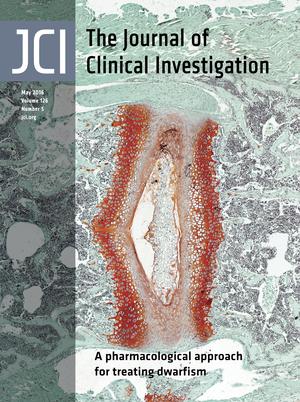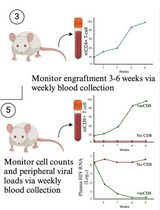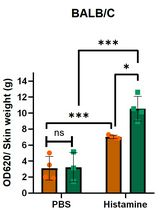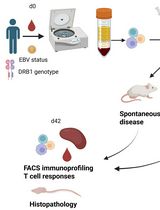- EN - English
- CN - 中文
Mono Sodium Urate Crystal-induced Peritonitis for in vivo Assessment of Inflammasome Activation
单钠尿酸盐晶体诱导的腹膜炎用于体内评估炎症体激活
发布: 2018年03月05日第8卷第5期 DOI: 10.21769/BioProtoc.2754 浏览次数: 9713
评审: Jia LiLokesh KalekarKathrin Sutter
Abstract
Due to its particulate material, mono-sodium urate (MSU) crystals are potent activators of the NOD-like receptor NLRP3. Upon activation, NLRP3 induces the formation of inflammasome complexes, which lead to the production and release of mature IL-1β. Bioactive IL-1β is a potent activator of innate immune responses and promotes recruitment of inflammatory cells, including neutrophils from the blood into damaged/inflamed tissues. This protocol describes a method to study in vivo inflammasome activation via intraperitoneal injection of MSU crystals. MSU-injection results in a drastic increase of intraperitoneal IL-1β levels, promoting neutrophil infiltration. Early-stage neutrophil numbers correlate with the amount of released IL-1β and can be used as a read-out for the extent of in vivo inflammasome activation. In addition, this protocol might also be used as a sterile peritonitis model, to investigate mechanisms of neutrophil recruitment to the peritoneum, or as a means to obtain large numbers of in vivo activated neutrophils.
Keywords: (sterile) Peritonitis ((无菌)腹膜炎)Background
Innate immune cells recognize pathogens through a set of pattern recognition receptors (PRR), which bind to evolutionarily conserved structures on the pathogen surfaces or through ligation of other danger-associated molecular patterns. One family of these receptors are the NOD-like receptors (NLR), which react to the intracellular presence of invading pathogens and/or intracellular danger signals (Meylan et al., 2006). Several PRR, including some NLRs are capable of inducing the formation of so-called inflammasome complexes, which mediate the proteolytic activation of pro-IL-1β, pro-IL-18, and other IL-1 family cytokines (Martinon et al., 2002). Due to the potent pro-inflammatory nature of IL-1β and IL-18, inflammasome activation is a highly regulated, two-step process, involving limited transcription of pro-IL-1β/pro-IL-18, and highly regulated activation of inflammasome receptors (Martinon et al., 2009). NLRP3, one of the most studied inflammasome receptors, responds to a great variety of intracellular danger-associated molecular patterns, including bacterial cell wall components (Martinon et al., 2004), damaged mitochondria (Zhou et al., 2011), and particulate materials (Martinon et al., 2006). Due to their particulate structure, mono sodium urate (MSU) crystals are very potent NLRP3 activators (Martinon et al., 2006), which are widely used for in vitro studies of NLRP3 activation.
In addition to its use for in vitro experiments, MSU can also be used to study the in vivo relevance of inflammasome activation. Here, we described an MSU-induced peritonitis model to easily and quickly study the in vivo relevance and extent NLRP3-inflammasome activation, e.g., upon genetic deletion of proteins that are involved in NLRP3 activation (Chen et al., 2006, Spalinger et al., 2016). In the MSU-induced peritonitis, the first wave of infiltrating immune cells consists mainly of neutrophils, and in the early phase of peritonitis, the number of infiltrating neutrophils correlates with the extent of inflammasome activation and with the production of mature IL-1β (Chen et al., 2006; Spalinger et al., 2016).
Materials and Reagents
- Pipette tips
- Insulin syringes (BD, catalog number: 324826 )
- 5 ml syringes (BD, catalog number: 302187 )
- 25 G needles (Terumo, catalog number: GS-351 )
- 50 ml tubes (Corning, Falcon®, catalog number: 352070 )
- FACS tubes with lid (Corning, Falcon®, catalog number: 352058 )
- Mice: C57BL/6 adult females (THE JACKSON LABORATORY, catalog number: 000664 )
Note: This protocol has been developed for C57BL/6 mice. For other mouse strains, MSU concentration and optimal time until peritoneal lavage should be titrated. - Mono-sodium urate (MSU) crystals (InvivoGen, catalog number: tlrl-msu )
- Fluorescent antibody against Ly6G (for example, AlexaFluor647 anti-Ly6G [clone 1A8], BioLegend, catalog number: 127609 )
- Fluorescent antibody against Ly6B.2 (also known as 7/4 antigen; for example Fitc anti-Ly6B.2 [clone REA115], Miltenyi Biotec, catalog number: 130-103-318 )
- Fluorescent antibody against CD3ε (for example, PE-CF594 anti-CD3ε [clone 145-2C11], BD, BD Biosciences, catalog number: 562286 )
- Fluorescent antibody against CD45 (for example, Pacific Blue anti-CD45 [clone 30F11], BioLegend, catalog number: 103126 )
- Live-dead discriminator (for example Zombie NIR Fixable Viability Kit, BioLegend, catalog number: 423105 )
- Mouse IL-1 beta/IL-1F2 DuoSet ELISA kit (R&D Systems, catalog number: DY401 )
- Substrate Reagent Pack (R&D Systems, catalog number: DY999 ) for ELISA
- Dulbecco’s modified PBS (Sigma-Aldrich, catalog number: D8537-500ML )
- Fetal calf serum (for example, PAN-Biotech, catalog number: P40-47100 )
- FACS buffer (see Recipes)
Equipment
- Pipettes
- Dissection tools (sharp scissors and forceps)
- Neubauer cell counting chamber or automated cell counter
- Refrigerated benchtop centrifuge
- Flow cytometer
- ELISA plate reader
Procedure
文章信息
版权信息
© 2018 The Authors; exclusive licensee Bio-protocol LLC.
如何引用
Spalinger, M. R. and Scharl, M. (2018). Mono Sodium Urate Crystal-induced Peritonitis for in vivo Assessment of Inflammasome Activation. Bio-protocol 8(5): e2754. DOI: 10.21769/BioProtoc.2754.
分类
免疫学 > 动物模型 > 小鼠
免疫学 > 炎症性疾病 > 炎性小体
细胞生物学 > 基于细胞的分析方法 > 炎症反应
您对这篇实验方法有问题吗?
在此处发布您的问题,我们将邀请本文作者来回答。同时,我们会将您的问题发布到Bio-protocol Exchange,以便寻求社区成员的帮助。
提问指南
+ 问题描述
写下详细的问题描述,包括所有有助于他人回答您问题的信息(例如实验过程、条件和相关图像等)。
Share
Bluesky
X
Copy link














